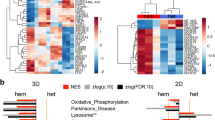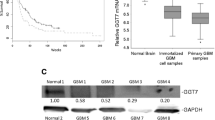Abstract
Glial cells are thought to protect neurons from heavy-metal toxicity. To gain a better understanding of mechanisms of protection against lead compounds, a number of lead-resistant C6 rat glioma cell sublines have been isolated. After 8 mo of growth in the absence of lead nitrate, three sublines still maintain their lead-resistant phenotype. None of the lead-resistant sublines are cross-resistant to Cd(II) or Ni(II), but all are cross-resistant (in varying degrees) to Hg(II), As(III), Sb(III), and Sn(II), and one is resistant to trimethyl tin. No inducible lead resistance is seen in any glioma line. One subline has been used to create cell-cell hybrids with wild-type cells. The hybrids exhibit dominance of the lead-resistant phenotype. To identify and analyze altered gene expression at the mRNA level in the lead-resistant sublines, the differential display technique was used. Numerous differences are seen between amplified fragments from wild-type and lead-resistant cells. Candidate clones are now being analyzed to confirm the differential expression and to isolate cDNAs that confer lead resistance.
Similar content being viewed by others
References
C. R. Angle, Childhood lead poisoning and its treatment,Annu. Rev. Pharmacol. Toxicol. 33, 409–434 (1993).
T. J. Simons, Lead-calcium interactions in cellular lead toxicity,NeuroToxicology 14, 77–86 (1993).
J. Markovac and G. W. Goldstein, Picomolar concentrations of lead stimulate brain protein kinase C,Nature 334, 71–73 (1988).
J. T. Naarala, Lead amplifies glutamate-induced oxidative stress,Free Radical Biol. Med. 195, 689–693 (1995).
P. Benda, J. Lightbody, G. Sato, L. Levine, and W. Sweet, Differentiated rat glial cell strain in tissue culture,Science 161, 370–371 (1968).
C. G. Naus, K. Elisevich, D. Zhu, D. J. Belliveau, and R. F Del Maestro,In vivo growth of C6 glioma cells transfected with connexin 43 cDNA,Cancer Res. 52, 4208–4213 (1992).
E. Tiffany-Castiglioni, D. M. Garcia, J-N. Wu, J. Zmudzki, and G. R. Bratton, Effects of lead on viability and intracellular metal content of C6 rat glioma cells,J. Toxicol. Environ. Health,23, 267–279 (1988).
E. Tiffany-Castiglioni, E. M. Sierra, J-N. Wu, and T. K. Rowles, Lead toxicity in neuroglia,NeuroToxicology 10, 417–44 (1989).
D. Holtzman, J. E. Olson, C. DeVries, and K. Bensch, Lead toxicity in primary cultured cerebral astrocytes and cerebellar granular neurons,Toxicol. Appl. Pharmacol. 89, 211–225 (1987).
M. Aschner, N. B. Eberle, S. Goderie, and K. H. Kimelberg, Methylmercury uptake in rat primary astrocyte cultures: The role of the neutral amino acid transport system,Brain Res. 521, 221–228 (1990).
A. M. Marini, J. P. Schwartz, and I. J. Kopin, The neurotoxicity of l-methyl-4-phenylpuridinium in cultured cerebellar granule cells,J. Neurosci. 9, 3665–3672 (1989).
P. Liang and A. B. Pardee, Differential display of eukaryotic messenger RNA by means of the polymerase chain reaction,Science 257, 967–971 (1992).
Z. Wang and T. G. Rossman, Stable and inducible arsenite resistance in Chinese hamster cells,Toxicol. Appl. Pharmacol. 118, 80–86 (1993).
D. Gartside, B. Weiss, and H. L. Evans, Alkylmercurial encephalopathy in the monkey (Saimiri sciureus andMacaca arctoides): A histopathologic and autoradiographic study,Acta Neuropathol. 32, 61–74 (1975).
B. Hitzfeld, F. Planas-Bohne, and D. Taylor, The effect of lead on protein and DNA metabolism of normal and lead-adapted rat kidney cells in culture,Biol. Trace Element Res. 21, 87–95 (1989).
Y. Skreb, V. Habazin-Novak, and N. Hors, The rate of DNA synthesis in Hela cells during combined long-term and acute exposures to lead,Toxicology 19, 1–10 (1981).
R. A. Goyer, P. May, M. M. Cats, and M. R. Krigman, Lead and protein content of isolated intranuclear inclusion bodies from kidneys of lead-poisoned rats,Lab. Invest. 22, 245–251 (1970).
B. A. Fowler, M. W. Kahng, D. R. Smith, E. A. Conner, and N. K. Laughlin, Implications of lead binding proteins for risk assessment of lead exposure,J. Expos. Anal. Environ. Epidemiol. 3, 441–448 (1993).
P. Mistry, G. Lucier, and B. Fowler, A High-affinity lead binding proteins in rat kidney cytosol mediate cell-free nuclear translocation of lead,J. Pharmacol. Exp. Ther. 232, 462 (1985).
Z. Wang, S. Dey, B. P. Rosen, and T. G. Rossman, Efflux mediated resistance to arsenicals in arsenic resistant and -hypersensitive Chinese hamster cells,Toxicol. Appl. Pharmacol. 137, 112–119 (1996).
B. J. Aungst and H. L. Fung, Kinetic characterization of in vitro lead transport across the rat small intestine: Mechanism of intestinal lead transport,Toxicol. Appl. Pharmacol. 61, 39–47 (1981).
J. L Tomsig and J. B. Suszkiw, Permeation of Pb2+ through calcium channels: fura-2 measurements of voltageand dihydropyridine-sensitive Pb2+ entry in isolated bovine chromaffin cells,Biochim. Biophys. Acta 1069, 197–200 (1991).
G. Audesirk and T. Audesirk, The effects of inorganic lead on voltage-sensitive calcium channels differ among cell types and among channel subtypes,Neurotoxicology 14, 259–265 (1993).
Y. C. Qian, E. Tiffany-Castiglioni, and E. D. Harris, Copper transport and kinetics in cultured C6 rat glioma cells,Am. J. Physiol, Cell Physiol. 38, C892-C898 (1995).
Author information
Authors and Affiliations
Rights and permissions
About this article
Cite this article
Dolzhanskaya, N., Gomcharova, E. & Rossmam, T.G. Isolation and properties of lead-resistant variants of rat glioma cells. Biol Trace Elem Res 65, 31–43 (1998). https://doi.org/10.1007/BF02784112
Received:
Accepted:
Issue Date:
DOI: https://doi.org/10.1007/BF02784112




